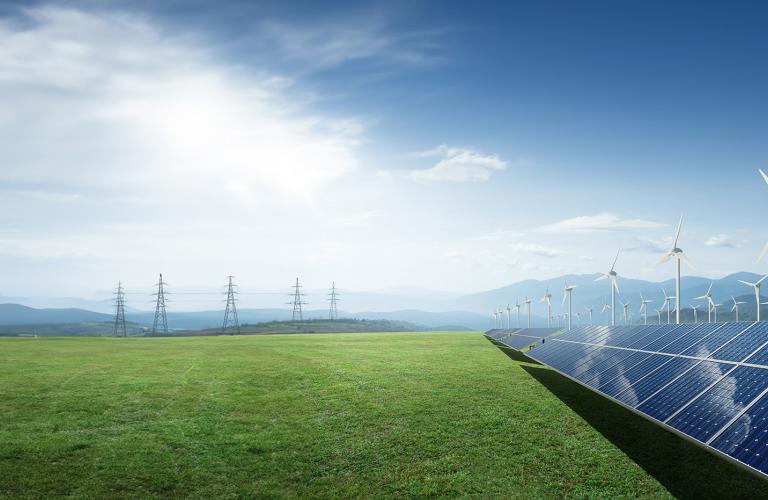The 2023 Global Institutional Summit brought industry leaders, asset allocators and policymakers together at the famous Harold Pratt House in New York City on October 3 to examine the forces reshaping the energy landscape and emerging investment opportunities.
Four key themes emerged from an afternoon of conversations among experts from across PGIM and the energy sector:
- Conventional energy has a bright future: Fossil fuels, particularly natural gas, have a critical role to play in the future of energy production and the transition to renewables. This is especially clear when evaluating the supply-demand imbalance across the globe, as well as the challenges of meeting current energy needs at a time when solar and wind comprise only a small portion of consumption—despite being the fastest-growing segment of the industry. Approximately 60% of the world’s population lives in energy poverty, while Europe and Asia consume more gas than they produce. Globally, energy demand is forecast to double by 2050. This will require continued investment in oil and gas. The energy transition could thus be dubbed an “energy addition,” as it will feature a diverse set of energy sources that require capital to innovate, grow and adapt. The supply outlook is brighter for natural gas when compared with oil, but the former needs market access to grow. There are investment opportunities in natural gas given the long-term outlook for demand and attractive prices for shale gas fields when taking into account projected cash flows. Private credit also presents interesting ways to invest in conventional energy. With banks retreating from the marketplace, smaller producers are turning to non-bank firms to fill the lending void. Shale players of all sizes are buying fewer new wells due to capital restraints, creating further opportunities in direct lending.
- Nuclear and key minerals have a crucial role: A diverse energy portfolio will also include nuclear, whose density makes it an efficient energy source. Nuclear has also proven to be a reliable power source through natural disasters and other energy crises. Net zero goals are likely unrealistic without the use of nuclear energy. Like fossil fuels, one of the biggest challenges weighing on nuclear’s growth prospects is the regulatory and policy environment. Regulations and permit processes—as well as the costs involved—have been an impediment to increasing capacity. Unfortunately, a crisis may be the spark for energy reforms. The energy landscape changed in significant ways following Russia’s invasion of Ukraine. The war encouraged European nations to rethink their energy policies, and policymakers expedited the process of building out new infrastructure and expanding capacity to head off a gas shortage. Still, Europe is facing a winter-by-winter situation over the next two to three years as the region manages limited inventories. The US and Europe are throwing fiscal support behind solar energy and battery technology, all while seeking to “de-risk” from China. However, China is at the center of most mineral supply chains. It is noteworthy that nuclear uses a small amount of critical minerals when compared with other energy sources. This is a dynamic that will likely influence policy going forward.
- Geopolitical forces are reshaping energy: The war in Ukraine and other geopolitical tensions have underscored that energy independence is a critical component of national security. Rather than climate-related concerns, energy security tends to drive action the most. For instance, the cascading impacts of the war—namely, disruption in the supply of Russian natural gas to Europe—has helped gather support for expanding nuclear capacity among some policymakers. France and Poland serve as two examples of nations that are forging ahead with nuclear plans. Recognizing that it can’t accomplish a green transition on its own, Europe is also seeking to increase supply from regions such as Latin America that do not raise security risks.
- The regulatory and policy environment is evolving: Regulators and policymakers face a host of challenges surrounding the energy sector, and uncertainty hangs over both fossil fuels and renewables. Decision-makers must balance affordability with other interests, such as climate concerns, cybersecurity risks to the power grid, and reliability. There is also an apparent need for permitting reforms to speed up energy production and mining for critical minerals. Meanwhile, recent events have highlighted energy’s role in national security, exemplified by the urgent need to meet energy demand in Europe following Russia’s invasion of Ukraine. These challenges will most likely be met through close partnerships with the private sector. Policymakers in the West are seeking closer ties with allies, and financial institutions are showing more interest in new energy investments that help achieve these policy goals and lower the risk of disruption to energy supply. Governments have been seeking input from industry leaders from across the energy spectrum to identify how policy can help companies and investors achieve their own risk objectives.
Events & Webinars
Join PGIM’s thought leaders and experts at upcoming events and conferences around the world.
Learn more
